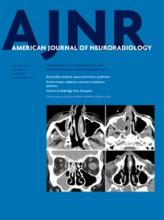Index by author
Fisicaro, R.A.
- FELLOWS' JOURNAL CLUBFunctionalYou have accessChallenges in Identifying the Foot Motor Region in Patients with Brain Tumor on Routine MRI: Advantages of fMRIR.A. Fisicaro, R.X. Jiao, C. Stathopoulos, N.M. Petrovich Brennan, K.K. Peck and A.I. HolodnyAmerican Journal of Neuroradiology August 2015, 36 (8) 1488-1493; DOI: https://doi.org/10.3174/ajnr.A4292
Thirty-five attending-level raters evaluated 14 brain tumors involving the frontoparietal convexity. Raters identified the location of the foot motor homunculus and determined whether the tumor involved the foot motor area and/or motor cortex by using anatomic MR imaging. Seventy-seven percent of the time raters correctly identified whether the tumor was in the foot motor cortex. Raters with fMRI experience were significantly better than raters without experience at foot motor fMRI centroid predictions.
Fodera, V.
- Adult BrainOpen AccessEvaluating CT Perfusion Deficits in Global Cerebral Edema after Aneurysmal Subarachnoid HemorrhageH. Baradaran, V. Fodera, D. Mir, K. Kesavobhotla, J. Ivanidze, U. Ozbek, A. Gupta, J. Claassen and P.C. SanelliAmerican Journal of Neuroradiology August 2015, 36 (8) 1431-1435; DOI: https://doi.org/10.3174/ajnr.A4328
Foong, J.
- Pediatric NeuroimagingOpen AccessTract-Based Spatial Statistics in Preterm-Born Neonates Predicts Cognitive and Motor Outcomes at 18 MonthsE.G. Duerden, J. Foong, V. Chau, H. Branson, K.J. Poskitt, R.E. Grunau, A. Synnes, J.G. Zwicker and S.P. MillerAmerican Journal of Neuroradiology August 2015, 36 (8) 1565-1571; DOI: https://doi.org/10.3174/ajnr.A4312
Forghani, R.
- Head and Neck ImagingOpen AccessOptimal Virtual Monochromatic Images for Evaluation of Normal Tissues and Head and Neck Cancer Using Dual-Energy CTS. Lam, R. Gupta, M. Levental, E. Yu, H.D. Curtin and R. ForghaniAmerican Journal of Neuroradiology August 2015, 36 (8) 1518-1524; DOI: https://doi.org/10.3174/ajnr.A4314
Frost, C.J.
- FELLOWS' JOURNAL CLUBHead and Neck ImagingOpen AccessAcute Invasive Fungal Rhinosinusitis: A Comprehensive Update of CT Findings and Design of an Effective Diagnostic Imaging ModelE.H. Middlebrooks, C.J. Frost, R.O. De Jesus, T.C. Massini, I.M. Schmalfuss and A.A. MancusoAmerican Journal of Neuroradiology August 2015, 36 (8) 1529-1535; DOI: https://doi.org/10.3174/ajnr.A4298
Two blinded neuroradiologists retrospectively graded 23 prespecified imaging abnormalities in the craniofacial region on CT examinations from 42 patients with pathology-proven acute invasive fungal rhinosinusitis and 42 control patients. A 7-variable model (periantral fat, bone dehiscence, orbital invasion, septal ulceration, pterygopalatine fossa, nasolacrimal duct, and lacrimal sac) was synthesized on the basis of multivariate analysis. The presence of abnormality involving a single variable in the model had an 87% positive predictive value, 95% negative predictive value, 95% sensitivity, and 86% specificity.
Gaillard, F.
- EDITOR'S CHOICEAdult BrainYou have accessImproving Multiple Sclerosis Plaque Detection Using a Semiautomated Assistive ApproachJ. van Heerden, D. Rawlinson, A.M. Zhang, R. Chakravorty, M.A. Tacey, P.M. Desmond and F. GaillardAmerican Journal of Neuroradiology August 2015, 36 (8) 1465-1471; DOI: https://doi.org/10.3174/ajnr.A4375
The authors evaluated and validated a semiautomated software platform to facilitate detection of new lesions and improved MS lesions. Two neuroradiologists retrospectively assessed 161 MR imaging comparison study pairs acquired between 2009 and 2011. More comparison study pairs with new lesions and improved lesions were recorded by using the software compared with original radiology reports.
Galinovic, I.
- EDITOR'S CHOICEAdult BrainOpen AccessHyperintense Vessels on FLAIR: Hemodynamic Correlates and Response to ThrombolysisA. Kufner, I. Galinovic, V. Ambrosi, C.H. Nolte, M. Endres, J.B. Fiebach and M. EbingerAmerican Journal of Neuroradiology August 2015, 36 (8) 1426-1430; DOI: https://doi.org/10.3174/ajnr.A4320
The authors evaluated 62 consecutive patients with ischemic stroke with proven vessel occlusion with MRI before and within 24 hours of treatment and defined a hypoperfusion intensity ratio (volume with severe/mild hypoperfusion [time-to-maximum ≥ 8 seconds / time-to-maximum ≥ 2 seconds]). Patients with extensive hyperintense vessels on FLAIR (>4 sections) had higher NIHSS scores, larger baseline lesion volumes, higher rates of perfusion-diffusion mismatch, and more severe hypoperfusion intensity ratio.
Gandhi, D.
- Review ArticleOpen AccessReversible Cerebral Vasoconstriction Syndrome, Part 1: Epidemiology, Pathogenesis, and Clinical CourseT.R. Miller, R. Shivashankar, M. Mossa-Basha and D. GandhiAmerican Journal of Neuroradiology August 2015, 36 (8) 1392-1399; DOI: https://doi.org/10.3174/ajnr.A4214
Geneser, M.
- Adult BrainOpen AccessMean Diffusional Kurtosis in Patients with Glioma: Initial Results with a Fast Imaging Method in a Clinical SettingA. Tietze, M.B. Hansen, L. Østergaard, S.N. Jespersen, R. Sangill, T.E. Lund, M. Geneser, M. Hjelm and B. HansenAmerican Journal of Neuroradiology August 2015, 36 (8) 1472-1478; DOI: https://doi.org/10.3174/ajnr.A4311
Gilbert, G.
- Pediatric NeuroimagingOpen AccessInjury to the Cerebellum in Term Asphyxiated Newborns Treated with HypothermiaS. Kwan, E. Boudes, G. Gilbert, C. Saint-Martin, S. Albrecht, M. Shevell and P. WintermarkAmerican Journal of Neuroradiology August 2015, 36 (8) 1542-1549; DOI: https://doi.org/10.3174/ajnr.A4326








